TV Choices Okay, But Content Has Gotten Worse
Americans are reasonably happy with the choice of what they can see on television, and there has been relatively little change in this sentiment over the past 11 years. A majority (55%) say they are at least “fairly satisfied” with the choices available to them (12% very satisfied, 43% fairly satisfied). Those who have more programming choices via cable or satellite and especially people who subscribe to premium channels are happier with the options available to them. Younger people express greater satisfaction with the choices than do older people.
People who watch top-rated reality television shows or those with sexual or violent content express somewhat greater satisfaction with available choices than do those who do not watch such programs. On the other hand, people whose preferences tilt toward more wholesome fare are no more satisfied than other viewers.

Despite expressing general, if unenthusiastic, satisfaction with the choices available, a two-thirds majority (66%) says that entertainment TV shows are worse now than they were five years ago. Just 24% say entertainment TV has gotten better. This pattern is almost identical to that seen when the question was asked in 1993 and in 1983. Older viewers, conservatives, and evangelical Protestants are especially likely to say that entertainment TV has gotten worse.
People who think TV is worse today than five years ago cite a range of concerns. About one-fifth each cite sexual content (22%) and violent content (21%), and another 16% mention the depiction of immoral behavior and a lack of good values. Compared with 12 years ago when this question was posed, far fewer today specifically mention sex and violence (in 1993, 38% cited violence and 33% mentioned sex). Women are more likely than men to cite sex and violence as reasons why TV has gotten worse.
Seventeen percent specifically said they dislike reality television, a type of programming that did not exist in its current form in 1993. But comparable numbers of people in 1993 and today said that TV programs lack substance (13% in 2005), had a bad influence on children (11%), or contained too much bad language and swearing (10%).
Among the roughly one-quarter of the public who feel that television has gotten better over the past five years, a plurality of 37% cited greater choice and diversity as the main reason and those who have cable TV, satellite dishes, or premium channels are even more likely to mention this. Other reasons included greater creativity or better acting (9%), better technology and special effects (9%), greater social relevance (8% compared with 24% who cited this in 1993), and greater educational value (8%).
Sex, Violence Low on Viewers’ List of Concerns
Despite the attention paid to sexual and violent content in entertainment television, only about a third of the public cites these as topics that personally bother them “a lot” on TV today. Just 33% say they are bothered a lot by homosexual characters and themes, 32% by adult language, 30% by sexual content, and 29% by violence. In contrast, far more (46%) are bothered a lot by reference to and depictions of drug use; 38% are bothered a lot by reality programs where real people are made fun of or tricked.
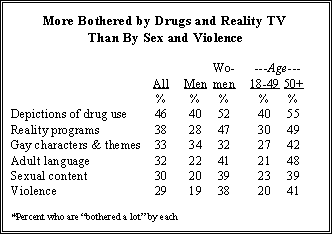
With the exception of gay characters and themes, women express more personal discomfort with these kinds of TV programming than do men. About twice as many women as men say they are bothered a lot by adult language (41% for women, 22% for men), by sexual content (39% vs. 20%), and by violence (38% vs. 19%). And far more older than younger viewers are bothered by each of these. For example, 48% of viewers age 65 and older are bothered a lot by sexual content in TV programs, compared with just 18% among those 18-29.
The pattern of dislikes differs for better educated and less-educated people. Viewers with a college degree are bothered most by reality programs (43% bothered a lot), while those with no more than a high school education are most apt to cite depictions of drug use (55%) and homosexual characters and themes (41%).
Sex vs. Violence

Asked to choose what concerns them most, a greater percentage of Americans say they are bothered more by the amount of violence on TV than by the amount of sex (43% violence, 33% sex); 17% volunteer that they are bothered equally by the two and 6% say that neither bothers them. Violence was also cited by pluralities as the greater concern in polls in 1997 and 1993.
Democrats cite violence on TV as the greater concern while Republicans divide relatively evenly between sex and violence as the greater concern. White evangelicals are much more concerned about sexual content than about violence, while mainline Protestants, black Protestants, Catholics, and seculars say violent content is the greater concern.
Divided Over Solutions
The public is divided in its assessment of the best way to curb violence and sex in the entertainment media. Fewer than a third (32%) think that government regulations and fines are the most effective way to reduce the amount of sex and violence in entertainment. Instead, 37% look to public complaints and boycotts as the most effective remedy, while 23% would rely on the industry to enforce its own rules.
Both conservatives and liberals (38% of each) share the view that, by a small margin, public complaints and boycotts are the most effective way to reduce sex and violence in the entertainment. Interestingly, among conservatives, government regulation runs a close second with 35% selecting it as the remedy most likely to succeed. By contrast, only 23% of liberals place their faith in government rules and fines.
In part, the reluctance to turn to the government may be owing to the widely held opinion that audiences wanting this kind of entertainment, rather than those who produce it, are primarily to blame for excessive sex and violence. Half of those surveyed blame audiences exclusively while another 13% say they share the blame with producers; only a third (34%) single out entertainment producers exclusively.

This is consistent with the view, held by the vast 86% majority, that parents have the most responsibility for keeping children from seeing too much sex and violence on television and in the movies. Only 8% assign that responsibility to the entertainment industry and a still smaller 4% put the onus on the federal government.
In general, there is little variation among demographic groups even between parents and non-parents in attitudes toward the government’s role in regulating entertainment. For example, the view that parents not the entertainment industry or the government are most responsible for keeping their children from exposure to offensive media is shared by more than 80% of all demographic, regional and political groups. The only slight exception is among black respondents, 77% of whom hold parents responsible while 15% accord primary responsibility to the federal government.
Younger people, especially younger men, tend to be more skeptical of government regulation. And only 32% of men age 18-49 think that the entertainment industry has transgressed the bounds of protected free speech, whereas two-thirds (66%) of the public over 65 think it has. By the same token, 58% of men age 18-49 see greater danger in the government imposing undue restrictions compared with only a third (33%) of those over 65.
Young people, however, are also more likely to put the onus on parents to supervise their children’s viewing habits–85% of those in the 18-29 age group say inadequate parental supervision, rather than inadequate government regulation is to blame for children being exposed to explicit sex or graphic violence, compared with 73% of those age 65 and over who hold this view.
By a margin of 48% to 41% the public also sees greater danger from the government’s imposing undue restrictions on the entertainment industry than from the industry’s producing material harmful to society. That same ambivalence is shown in responses to the question of whether entertainment producers have gone beyond their constitutional rights of free speech (48% agree) or remained within those rights (46%).
And while a substantial majority (57%) agrees that there are basic standards of decency that the entertainment media should follow, a sizeable minority (39%) worries that no basic set of standards can work because everyone has different views about what’s offensive or not.
Anti-Indecency Proposals Draw Support

Despite these reservations, broad support exists for all of the several regulatory proposals currently debated including, in order of preference, stricter government enforcement of decency rules during hours when children are more likely to be watching television (75% favor), increased government fines on broadcasters that violate indecency rules (69%), the imposition of a common rating system for television, movies, video games and music lyrics (61%), making cable television follow the same decency rules as broadcast television (60%), and public boycotts of networks and studios that produce objectionable material (58%).
Liberal Democrats are least likely to favor stricter controls on the media, with roughly half favoring each type of control. Conservative Republicans, however, strongly favor added sanctions with more than eight-in-ten favoring an enforced family hour on TV and increased fines. About 80% of moderate and liberal Republicans as well as conservative and moderate Democrats also strongly favor a required family hour as do women generally.
White evangelical Protestants, frequent churchgoers, and those attending places of worship where the clergy talk about excessive sex and violence in the media also favor governmental regulation more heavily than do other groups. Among evangelicals, 70% favor boycotts of offending networks or studios and upwards of 80% favor the other types of controls.
Also, unlike the general public, evangelicals, as well as those whose clergy discuss the subject, are considerably more concerned (by a margin of about 51% to 36% in both groups) that the entertainment industry will produce harmful material than that the government will impose undue restrictions.
The Media and the Nation’s Children

New media forms are fast edging out older, more familiar types when it comes to concern about which sources of entertainment are most likely to harm the nation’s children. The public now selects the internet as the top potential threat, with nearly three-quarters (73%) saying that they were “very concerned” about internet-carried material reaching children.
Music lyrics, television and video games were in a virtual tie for second place, with about six-in-ten respondents saying they were very concerned about their impact on youth. A slightly smaller percentage (56%) cited the same level of concern about movies.
In the case of the internet, concern appears to be rising. In a May 1999 survey, 64% said they were very concerned about the internet reaching children, compared with the current 73%. With respect to TV, movies and video games, concern is basically unchanged. ( The 1999 survey did not ask about music lyrics.)
The internet is again cited most frequently when it comes to choosing the one type of entertainment media that people were most concerned about, with 37% singling it out. Television ranked second, with 27% selecting it, followed by music lyrics (16%), and video games (13%). Only 3% chose movies as the greatest source of concern. In the May 1999 survey, television led the list of top media concerns with 39% selecting it although internet followed closed with 36%.

Reasons for designating a primary source of concern vary with the entertainment form selected. Respondents who chose the internet, music lyrics or video games most frequently volunteered answers relating to content including exposure to sex, violence, bad language and other bad influences. In the case of television, however, the worry that children spend too much time watching it outweighed content concerns by 39% to 35%.
The internet, however, poses some special challenges. The difficulty that parents experience in controlling children’s access to the internet was cited by 34% of those choosing it as their greatest concern. In addition, in expressing concerns about objectionable content, one-in-five respondents (21%) referred to its easy accessibility on the internet. Other worries unique to the internet are concerns about exposure to child predators and other possibly dangerous persons through chat rooms and the like.
These concerns persist despite the large number of parents who now report that they are using filters on their personal computers to monitor or limit access by their children to internet content. As noted later in the report, among parents with access to the internet, half (51%) said they installed a filter to prevent access to pornography, including 59% of parents with children old enough to be likely to access the internet on their own.
The general public is somewhat less concerned about the exposure of children to television advertisements. Only 36% say they are very concerned about this, although another 37% express some concern. And when asked which is a greater source of concern, television programs or television advertisements, people select programs over ads by a lopsided 62%-25% margin, with another 11% saying both or neither of them.
Who worries most about what

As expected, parents tend to be among those groups most concerned about the exposure of the nation’s children (not specifically their own children) to harmful entertainment material. Concerns are strongest with respect to the internet, with 81% of parents saying they are very concerned, compared with 69% of non-parents. In general, levels of concerns about all of the various media types are several percentage points higher among parents than among those without children of their own.
Concern about children’s exposure to entertainment tends to increase with age, although there is no consistent pattern among types of entertainment media. Concern about the internet is highest (76%) among people age 30-to-65; concern about television peaks at about 70% among those 50 and over.
Video games are of greatest concern to people in the 50-64 age bracket — 69% of this group are very concerned about children’s exposure to games compared with only 47% of those age 18-29. Worry levels among younger adults approach those of older age groups only with respect to the internet. About two-thirds (67%) of those under age 30 express a high degree of concern about internet-carried material.
Levels of concern are also high among regular attendees at religious services, and especially among those who attend services where clergy speak out about too much sex and violence in television and movies. Among the latter group, 85% are very concerned about the internet and upward of 70% are very concerned about the other media forms.
There is little difference in intensity of concern among Republicans, Democrats and independents, but those identifying themselves as political conservatives register levels of concern similar to those reported by frequent churchgoers.
Bigger Problems
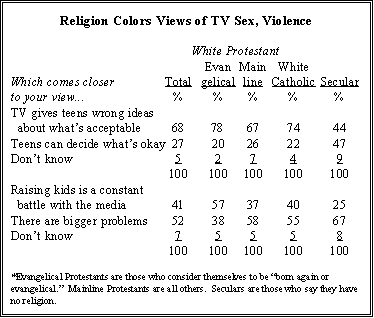
Still, despite these concerns, a slight majority (52%) feels that there are much bigger problems out there for raising kids today than what they see and hear in the media. Younger adults are likely to be the least concerned about the media’s effect on child rearing. Among those in the 18-29 age bracket, fewer than a third (32%) agree that raising kids today is a constant battle with the media, compared with a uniform 43% across all higher age groups. And six-in-ten (61%) of those age18-29 see bigger problems than the media in this regard, compared with roughly 50% of those in the middle-age ranges and 46% of those age 65 and older.
However, those who identify themselves as “born again or evangelical” Protestants are more likely than other groups to view today’s media as a severe problem in child rearing. Among evangelical Protestants, 57% say that raising children is a constant battle with the media to teach right from wrong, while only 38% say that there are bigger problems in raising kids than exposure to the media.
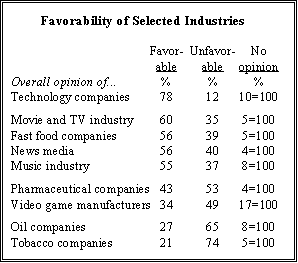
Sizing up the Entertainment Industry
Despite these reservations, the entertainment industry, or at least its more traditional components, scores reasonably well in public esteem. The motion picture and entertainment television industries are viewed at least somewhat favorably by 60% of the public. That’s well below the 78% approval rating earned by technology companies, but it beats out the news media, which are tied with the fast food industry at 56% approval. Close behind, the recording and music industries are viewed favorably by 55% of the public.
The really bad evaluations are reserved for the video game manufacturers. Their 34% favorable rating is lower than the 43% accorded the pharmaceutical industry, itself the frequent target of consumer concerns about high prices and safety.

However, video games still top the 27% and 21% approval scores earned, respectively, by oil companies and the tobacco industry.
A slight hometown bias is observed in industry approval ratings across regions. The motion picture and entertainment television industry reaps its highest rating (65% approval) in the West, its primary place of residence. Oil companies score their modest peak approval (34%) in the South, home to the oil patch. Tobacco’s poor favorability ratings in the Midwest (25%) and South (24%) are still more than double its abysmal popularity level (11%) in the East.
On the political front, the most sizeable difference among parties is seen in the relatively low regard among Republicans for the motion picture and television industry. Only 48% of Republicans view movie and TV producers favorably, compared with 66% of Democrats and 63% of independents. On the other hand, 62% of Republicans look favorably upon the fast food industry, compared with only 53% of Democrats and 55% of independents.
Parental Concerns About TV

The overall patterns in public opinion toward TV content are mirrored in parental concerns. As is true for the general public, parents’ worries over what their own children are watching on TV are not limited to sex and violence. And like the general public, parents worry about their own children being exposed to references to illegal drugs and depictions of drug use on TV. Indeed, among parents this ranks as high as concerns over sexual content (44% cite illegal drug references as a major concern compared with 43% who cite sexual content).
Other types of television content are viewed as somewhat less worrisome by parents, although majorities expressed at least some concern about every item tested. Nearly four-in-ten interviewed expressed a great deal of concern over their children being exposed to violent content and adult language (37% each). Somewhat fewer (32%) said they were very concerned about their children watching programming with homosexual characters and themes.

Mothers tend to be more concerned than fathers about several areas of television content, especially violence 45% of mothers express a great deal of concern over their children being exposed to violence, compared with 30% of fathers. Nearly as many mothers (42%) were greatly concerned by adult language on television, compared with 32% of fathers.
Religious observance and education are also factors in determining the extent to which parents worry about television. Those who attend church at least weekly express much higher levels of concern over all aspects of television content than parents who attend less frequently. Among these parents, sexual content ranks as their top concern, with 56% saying it concerns them a great deal. Parents with a high school education also express generally higher levels of concern about TV content than do college graduates.
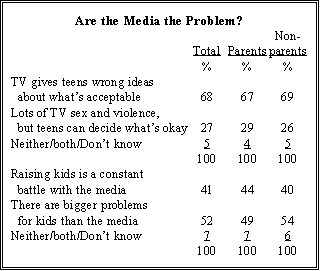
A Constant Battle
Parents agree that exposure to so much sex and violence on television gives children and teens the wrong ideas about what’s acceptable in society, although their views are not greatly different from those of the larger public. Only 27% of the public feel that most children and teens can tell the difference between what they see on television and what’s okay to do. Still, a majority (52%) feel that there are much bigger problems out there for raising kids today than what they see and hear in the media.
However, those parents who identify themselves as “born again or evangelical” Protestants not only express the highest level of concern about sex and violence on television but also disagree with other groups in assessing the severity of the problem. Among evangelical parents, 62% say that raising kids is a constant battle with the media to teach right from wrong, while only 35% say that there are bigger problems in raising kids than exposure to the media.

And while parents in different age groups share the same level of concern that TV distorts teenagers’ judgments about right and wrong, young parents (those under 30) are considerably less likely to see themselves locked in battle with the media over the proper raising of their children. Of those under 30, 34% see a constant battle with the media while 56% think there are much bigger problems for raising kids today. By comparison, parents 30 and over split about evenly between these two views.
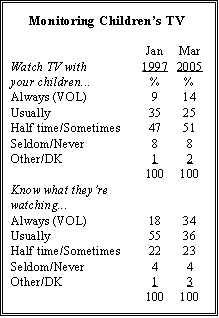
Concern Drives Greater Monitoring
Most parents say they watch television with their children at least occasionally, though only about four-in-ten (39%) say they always or usually do so. Among those with children under five, nearly half (47%) always or usually watch.
Parental monitoring of children’s television viewing has not changed much since 1997, when 44% said they always or usually watched with their children. But there has been a sharp rise in the percentage of parents who say they always know what their children are watching. Roughly a third (34%) volunteer this today, compared with just 18% eight years ago. However, the numbers of parents who say they always or usually know what their children are watching has not changed significantly (70% currently compared with 73% in 1997).
Setting Rules for Television
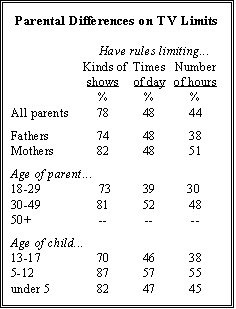
In setting limits on television viewing, parents are most likely to specify the kinds of shows their children are allowed to watch. Nearly eight-out-of-ten parents (78%) say they have such rules. Less frequent are rules governing allowable times of day for watching television (48%) or number of hours of viewing (44%).
Looking at differences across demographic groups, parents who are somewhat older tend to be stricter than younger parents with regard to television viewing: 81% of parents age 30-49, for example, set limits on types of shows compared with 73% of parents age 18-29; 52% of the older group limit times of day for watching compared with 39% of the younger parents.
Similarly, parents with younger children are more likely to impose rules, especially limits on types of shows, than are those with teenagers. Mothers tend to be stricter rule-setters than fathers, as do parents with at least some college education compared with those with a high school degree or less. Regular churchgoers are slightly more likely to impose all types of rules (86% limit shows, 54% limit times of day and 48% limit hours of watching).
Internet Controls
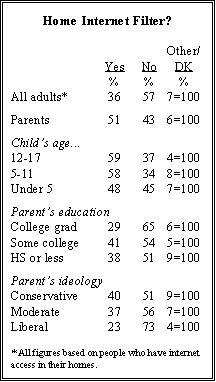
Television, however, is no longer the major media worry for many parents. As noted elsewhere, eight-in-ten parents (81%) now rate the internet as a source of great concern about its influence on the nation’s children generally. (Parents were not questioned specifically about the influence of media other than television on their own children). As a source of general concern about children’s exposure to them, video games and music lyrics were cited by as many parents (67%) as was television.
Among parents with access to the internet, half (51%) said they had a filter installed to prevent access to pornography. That proportion rises to nearly six-in-ten among parents with children old enough to be likely to access the internet on their own. Similarly, in a March 2005 survey of 1,100 youths ages 12 to 17 and their parents, the Pew Internet and American Life Project found that 54% of internet-connected families now use some type of filter or monitoring software, a 65% increase over the number who did so in 2000.
Seven-in-ten parents (70%) with a home computer, (56% of all parents) say that their children ever use it to play games. Among all parents, 72% say they have a video game system in their household such as Playstation, X-box or GameCube that can be hooked up to a television set.
Rating the Ratings
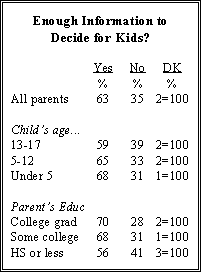
Most parents are reasonably content with the guidance provided by available information and rating systems in deciding whether movies, television, video games and music lyrics are appropriate for their families.
More than six-in-ten (62%) say they find enough information available to help them make such decisions. That is especially true of parents of younger children 68% of those with children under 5 and 65% with children age 5-12 say that information on media content is sufficient. More highly educated parents also express higher levels of satisfaction with available information: 70% of those with a college degree or more say they have enough compared with 56% of those with a high school degree or less.
Relatively few parents rely heavily on entertainment industry rating systems. The proportion of parents placing a “great deal of trust” in rating ranges from 17% for video game ratings, 18% for television show ratings, and 21% for music lyric parental advisory labels to 24% for movie ratings. However, adding in those who say they put “a fair amount” of trust in the respective rating systems produces overall trust levels ranging from 59% for video games, 63% for music lyrics and 67% for television shows to 75% for movies.
Where the Buck Stops
There is now little question in the public mind that if children are being exposed to objectionable material through the media, the primary fault lies not with the government or the entertainment industry, but with parents. In this, parents are in full agreement.

Nearly eight-in-ten (79%) of the public, and a virtually identical 78% of parents say that inadequate parental supervision is most responsible for children being exposed to printed or video materials depicting explicit sex or graphic violence. Only 13% pointed to inadequate laws or law enforcement, with 7% volunteering both. Those percentages differ significantly from the numbers recorded in response to a similarly worded question in an April 1997 Pew survey in which 59% put the blame on inadequate parental supervision, while 38% blamed either laws and enforcement or both.
Moreover, the public overwhelmingly holds parents responsible even when the entertainment industry is thrown into the mix. When a separate group of respondents was asked whether the federal government, the entertainment industry or parents bear the greatest responsibility for keeping children from seeing too much sex or violence, 86% cited the parents. Only 8% chose the entertainment industry and 4% the federal government. Again, the views of parents and non-parents are virtually identical on this issue.
Today’s Moral Standards
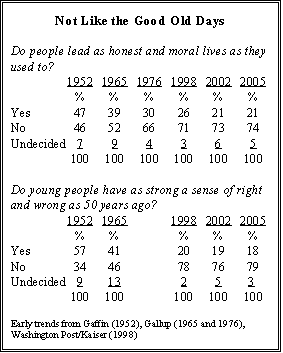
Americans continue to take a dim view of the moral standards of their modern day fellow citizens compared to those of days gone by. Asked if they think that people in general today lead as good lives honest and moral as they used to, only 21% say yes while 74% say no. These ratings are unchanged from those recorded in a March 2002 Pew survey and down only slightly from responses in a November 1998 Washington Post/Kaiser poll suggesting that the downward trend in morality ratings may have bottomed out.
The same strongly negative long-term trend is observed when respondents are asked to compare today’s youth with those of the past. Asked if young people today have as strong a sense of right and wrong as they did, say, fifty years ago, only 18% say yes, while 79% say no. This is about the same margin recorded in surveys since 1998, but, again, substantially more negative than those recorded decades ago. In a June 1952 survey, for example, nearly six-in-ten respondents judged that youth of that era were as sharply attuned to right and wrong as their forebears.
Despite this concern about prevailing moral standards, 54% of those interviewed say that they attend religious services at least once or twice a month and 39% say that they attend once a week or more. Moreover, 55% of these regular churchgoers (30% of the entire sample), say that the clergy at their place of worship speak out about too much sex and violence in television and movies.




